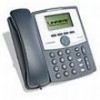Linksys SPA922 Cisco SPA9000 Voice System Web-UI Based Product Installation an - Page 100
Using Direct Inward Dialing to Phone Extensions, <Extn1>
 |
UPC - 745883570836
View all Linksys SPA922 manuals
Add to My Manuals
Save this manual to your list of manuals |
Page 100 highlights
Configuring Phone Service and Voice Mail Configuring Inbound Call Routing 5 STEP 7 To verify your progress: a. Verify that incoming calls are routed directly to the desired extension number. b. If you configured a call forward option, verify that the call is forwarded correctly after the specified Call Forward No Answer time. Using Direct Inward Dialing to Phone Extensions Direct Inward Dialing allows the external users to dial directly any phone extension in the SPA9000 Voice System, without passing through the Auto Attendant or the receptionist. Before proceeding with the configuration you need to have the full correspondence between the external (DID) number and the extension number. NOTE • Direct Inward Dialing requires network support for SIP trunking DID. • It is important that the DID number format match exactly the format of the number signaled in the SIP trunk. • Please check with your Service Provider to confirm the availability of this feature and the correct DID number format, before proceeding with this configuration. SYNTAX: :+ | :+ | :+ | :+ | :+ | :+ | :+ | :+ | :+ | :+ | :+ | :+ | :+ | :+ | :+ | :+ | • Enter a plus (+) or a minus (-) before the extension number to achieve the desired results for caller ID and call routing: • + The extension will be alerted when there is an incoming call to the DID number, and the DID number will be used as the local user-ID in outbound SIP requests, along with the display-name of the extension. SPA9000 Voice System Installation and Configuration Guide for Web UI 98















